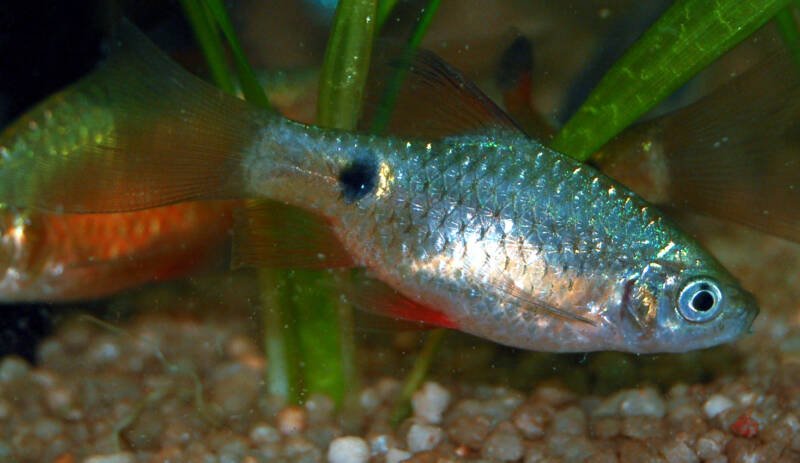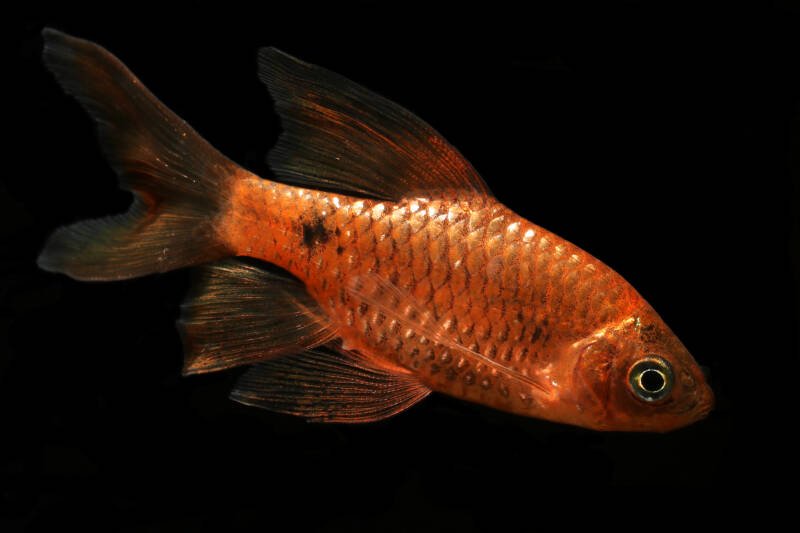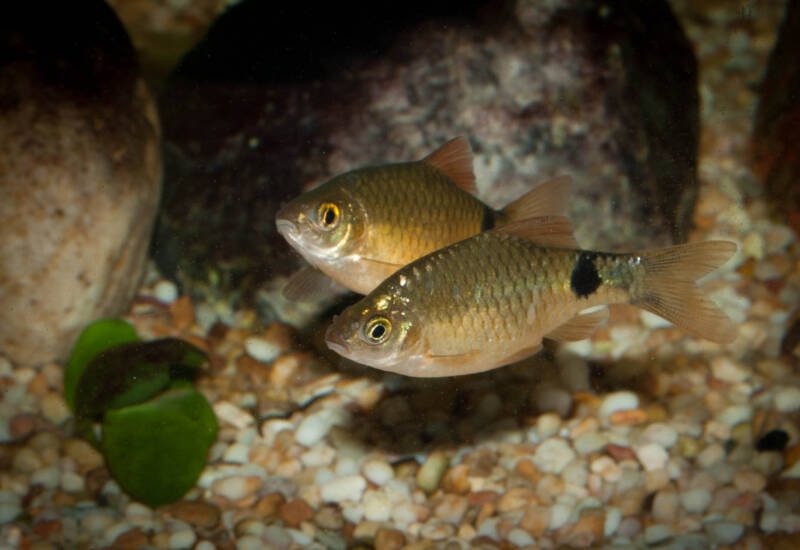Have you seen the mesmerizing display of rosy barbs in an aquarium?
These captivating fish have become a top choice for both novice and expert aquarists due to their stunning appearance and ease of care.

With their vibrant coloring, hardiness, and peaceful nature, rosy barbs have quickly gained popularity and are readily available in stores. They can be kept in a species-only tank or a community setup, adding a splash of color to any aquarium.
Another perk of rosy barbs is their adaptability to a range of environments, making them a great choice for those who prefer a low-tech or more affordable setup.
So why not add some rosy barbs to your tank and enjoy their beauty and tranquility?
At a Glance
| Min tank size: | 30 gal (120 l) |
| Lifespan: | up to 5 years |
| Group size: | in big groups |
| Size: | up to 6 inches (15 cm) |
| Temp: | 64-72°F (18-22°C) |
| pH: | 6.5 |
| Hardness: | up to 10 dGH |
| Ammonia and nitrite: | 0 ppm |
| Nitrate: | < 5 ppm |
In this article
Appearance and Cyprinid Characteristics

The rosy barb’s appearance changes drastically depending on its gender.
Males are bright red or orange, while females appear more gold or silver. Both sexes have black markings on their fins and sides, although the extent of these markings varies by individual. They have a forked tail and only one dorsal fin.

This species is also cyprinid fish, which means it has the following characteristics:
- no adipose fin, but a second dorsal fin (behind the first one) is present
- no stomach or teeth though they have rows of gill rakers
- an acute sense of hearing due to three specialized vertebral processes
The male coloring is what inspired its common names, the rosy barb and red barb. These names are both accurate and notably easier to roll off the tongue, as opposed to its scientific names, of which it also has several.
Puntius conchonius and Pethia conchonius are its two most well-known names currently though it also used to be referred to as the Barbus conchonius.
Compared to other barbs, rosy barbs are one of the larger species and can grow to 6 inches (15 cm).
However, they are relatively small compared to other cyprinids, the largest of which is the giant barb. The giant barb can grow up to a whopping 10 feet (3 m) long and weigh more than 600 Ibs (272 kg) in the wild.
They typically live five years or less, which makes them neither the shortest- nor the longest-living barb or schooling fish. Rather, these species are a solid intermediate option.
Usual Behavior

Like many schooling species, the rosy barb loves company. When it’s bereft of this and housed in small groups, it tends to become aggressive and engage in fin nipping.
As your school grows larger in the aquarium, this fish will become more active, confident, and happy. Its tendency to nip fins and chase other fish will be greatly reduced.
Aggressive interactions aside, the rosy barb will interact less with other fish when it has a considerable school to swim in.
Once it becomes comfortable and has a large school to lend confidence, rosy barbs will inhabit all levels of the aquarium. They are active swimmers and will often travel around the tank. However, aquariums must have a secure lid, as rosy barbs are active jumpers.
Native Habitat
If the water is warm and fast, you can expect to find this tropical fish there. Rosy barbs are originally from Northern India.
There, you can spot schools with thousands of barbs inhabiting fast-flowing lakes and warm rivers. Native populations have also been spotted in Assam, Singapore, Australia, Mexico, Puerto Rico, and even Columbia.
Though they live in schools, they are often found in areas populated by a variety of other fish.
Aggressive tendencies can arise as a result of competition for territory or food, though on the whole rosy barbs are peaceful and do well in these environments.
Creating a Rosy Barb Aquarium

Because of its size and schooling classification, this fish needs a minimum of 30 gallons. Keep in mind, this is for a species-only small school.
If you want to keep a community tank or have a large school (remember: more barbs = happy barbs), you’ll need to significantly upsize your tank.
Like any fish, rosy barbs appreciate new driftwood, rocks and caves, and other décor to explore. But these elements are not as integral to their health as they are for other types of fish.
Long tanks rather than tall tanks are better for this fish since the school will have plenty of room to roam.
Rosy barbs also like aquatic plants, though silk or other types of fake plants will also work.
But if you have live plants, be warned: they like to nibble on soft-leaved plants and will make them part of their regular diet.
If you keep live plants, appropriate lighting and substrate are necessary to support their continued growth.
Fortunately, rosy barbs do well with “low-tech” plants like java moss that don’t require a CO2 setup or expensive lighting systems. LED lights and a plant substrate or regular nutrient dosings will create a thriving aquarium environment.
Required and Useful Equipment
Rosy barbs are low-maintenance fish compared to many other species and only truly need a filter and heater to feel comfortable.
However, water movement, lighting, and substrate choices can all have a positive impact on the life and behavior of these fish.
- Filtration: Almost any type of filter will work well with rosy barbs, even HOB and internal filters that have more powerful outputs. These fish appreciate a decent current, so water movement isn’t a problem.
- Heating: Though rosy barbs can tolerate cooler temperatures and can survive in a larger range than many other fish, they still prefer warmer water. As such, a heater and thermometer are tank essentials.
- Wave Makers: If you have a powerful filter, a wavemaker may not be necessary. But if your filter isn’t strong enough, this piece of equipment will create a much-needed current throughout the habitat.
- Lighting: Rosy barbs (and live plants) appreciate a regular day-night cycle, however, 24-hour lighting isn’t necessary. Instead, establish a “day” and “night” period by manually turning the lights on and off or by using a light timer.
- Substrate: Because of their coloring, these bright fish pop best against a dark substrate. However, the type of substrate can vary: sand, plant substrate, and rocks will all entice rosy barbs to display natural behaviors.
The type of plants you keep in your aquarium may guide some of the equipment you buy, such as the lighting setup and type of substrate.
However, there are many choices available that will suit this species. This makes them a cost-effective fish in terms of initial purchase and tank setup.
Necessary Water Parameters

Because of their easy care, rosy barbs can tolerate a wide range of water parameters.
They are also more tolerant of incorrect parameters, and won’t immediately suffer negative health effects if you miss a tank cleaning.
However, this does not mean that they shouldn’t be kept in water parameters that fit their preferences. Below are their preferred ranges for pH, dGH, and more.
- pH – In the aquarium, the pH should be kept close to neutral but slightly acidic; 6.5 pH is the sweet spot for this species, although they can tolerate above and below this number.
- dGH – Rosy barbs are a low-maintenance species that can easily live within a range of general water hardness, all the way up to 10 dGH.
- Temperature – Neither entirely coldwater nor tropical, rosy barbs enjoy a temperature range of 64 to 72°F (18-22°C) but are most active in the upper half of this range.
- Ammonia – Because they’re hardier than other species, rosy barbs can survive higher levels of ammonia. However, they will only truly thrive if levels are kept close to 0 ppm.
- Nitrites – Just like ammonia, rosy barbs can technically live in water conditions with higher levels of nitrites. But responsible aquarists should keep nitrite levels around 0 ppm.
- Nitrates – Rosy barbs are more tolerant to nitrates and can survive higher levels but still thrive best when kept in a clean tank with nitrates under 5 ppm, preferably 0 ppm.
For rosy barbs to show their full coloring, be active, and display natural behaviors, it’s important to try and match these water parameters.
Some deviation is fine, and even to be expected in an aquarium. However, tank owners should test their parameters regularly to make sure they don’t stray too far from the rosy barb’s preferred levels.
Tank Mates and Compatibility
Because of its potential aggression, rosy barbs are best housed with fish that are peaceful, fast-moving, and short-finned.
When these criteria are met, and the rosy barbs have a large school to depend on, they socialize well and are a great addition to community tanks.
In the video below, you can clearly see how fast-swimming rosy barbs stress a less agile school of angelfish.
Rosy barbs also do better with fish that prefer similar water parameters. Freshwater fish that like current and warmer temperatures are advisable.
Some common tankmates include:
- Swordtails
- Gouramis
- Knife fish
- Ropefish
- Paradise fish
- Danios
- Tetras
- Cichlids
With regard to cichlids specifically, hobbyists have reported moderate to great success using rosy barbs as dither fish.
No matter what kind of fish you choose for a community tank, make sure they all thrive in the same water parameters and have similar temperaments.
For example, white cloud minnows would be incompatible with rosy barbs because of the minnow’s preferred temperature range. Goldfish would be an unwise companion since they are long-finned and slow-moving.
Food and Diet
The rosy barb is an omnivore that will take advantage of any food you add to the aquarium.
They will accept a variety of foods, ranging from vegetables to live, meaty foods and, as noted earlier, plant matter. Some of their favorite foods include:
- Tubifex
- Bloodworms
- Brine shrimp
They’ll also gladly munch on more unusual foods that other fish would reject, such as:
- Insects
- Crustaceans
- Zucchini
- Peas
- Algae
When feeding rosy barbs vegetables, thaw and boil them first. If the vegetables are fresh, they should still be boiled.
Rosy barbs will accept food that is frozen, live, and freeze-dried. They’ll also accept flake foods and pellets, although these are generally less nutritious than the foods listed above.
Because of their voracious appetites, owners should be careful of overfeeding. Only give rosy barbs what they can eat within two minutes, and stop if you see their stomach bulging. A slight roundness is acceptable, but a “food baby bump” is a sign to stop.
Are Rosy Barbs Your Next Fish?
Though their size and need for a school necessitate a larger tank, these fish are still great for beginners. They are one of the hardiest types of barbs and have been known to tolerate cycling in new tanks and a missed cleaning in established tanks.
Overall, their easy temperament, beautiful coloring, and fun behaviors make them an excellent addition to species-only and community tanks.
Their schooling movements are truly a sight to behold, and their colors create an underwater light show.